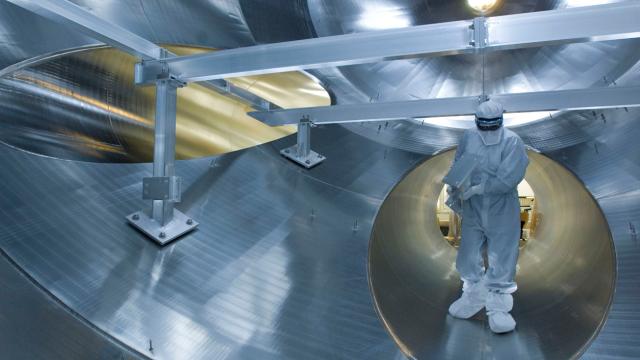When it comes to understanding the universe, a crucial property of stuff, whatever that stuff might be, is its mass. The building blocks of our world, things like the elements or subatomic particles, have pretty consistent masses. One physics team continues to find a strange discrepancy in the masses of some basic particles you may have heard of.
The KATRIN experiment (Image: KATRIN/Karlsruhe Institute of Technology)
Researchers from Florida State University, Tallahassee have been measuring how the masses of a few species of hydrogen and helium stack up against one another. Their newest results don’t line up with values taken from scientific literature. And these measurements could have some implications for a different experiment, which is trying to figure out the mass of the another particle, the electron antineutrino.
Physicists know that neutrinos and their antiparticles, called antineutrinos, have mass. They don’t know what those masses are. The KArlsruhe TRItium Neutrino (KATRIN) experiment in Germany is to attempting to measure the mass of a particle called the electron antineutrino by observing the radioactive decay of tritium, a hydrogen atom with two neutrons and a proton.
Tritium loses an electron and an electron antineutrino through beta decay, turning into helium-3, an atom with one neutron and two protons.
One useful piece of data to help check the results of the KATRIN experiment is the energy released by tritium during this decay, Edmund Myers, Research Professor and Distinguished University Scholar in the Department of Physics at Florida State University, Tallahassee, explained to Gizmodo.
His team previously made measurements trying to determine the mass difference between tritium and helium-3, using a ratio of their behaviours in a kind of magnetic particle trap, called a Penning trap. It proved difficult to measure the difference directly, so they instead measured the mass of both against an intermediary: hydrogen-deuteride, or hydrogen with a single proton bonded to a deuteron, a nucleus containing a proton and a neutron.
Soon after publishing their first results, another team at the University of Washington measured the mass of helium-3 and deuterium with a different method.
There was an inconsistency between the results of Meyer’s team’s Penning trap approach and the individual values from the University of Washington team combined with those from other research. More precise measurements of the proton’s mass have also since been published from a German team with scientists affiliated with KATRIN. This reduced, but did not eliminate, the discrepancy.
Is the discrepancy due to some underestimated error in Myers’ teams initial results, or due to issues with the measurements of the mass of the proton, the deuteron, and helium-3? His team performed the measurements once again after making some tweaks to their apparatus. Their new result, published last week in Physical Review A, agrees with their first measurement, and is still inconsistent with the masses of the individual particles gathered from the University of Washington team and the German team.
But what does this all mean, that masses of these particles, when calculated based on the ratio of their behaviours in an experiment, differ from their individual masses combined?
Alan Poon, physicist at Lawrence Berkeley National Laboratory, told Gizmodo that these measurements help KATRIN’s sensitivity in measuring the neutrino mass and may go into their analysis, though other methods will be used to determine the mass difference between tritium and helium-3. Diana Parno, Carnegie Mellon physicist involved with maintenance, operation and characterisation of the main KATRIN detector system, agreed with Poon.
She also said that, speaking as a non-expert in precision measurement, “these measurements are quite interesting for our understanding of nuclear structure, and I am watching this with interest.”
Experts in the field of precision measurement are interested in these results as well. “The work is valuable for the redefinition of the SI units based on fundamental constants,” Jun Ye from the JILA at the National Institute of Standards and Technology in Colorado told Gizmodo. He did point out that the paper made one reasonable assumption based on the nature of hydrogen-deuteride, but that a direct check on that assumption “might be worthwhile.”
Myers would not comment on any of the other teams’ results, and downplayed the importance of his results to the redefinition of SI units. He told Gizmodo in an email that “FSU has some confidence in FSU’s results because, as stated in the paper, major upgrades were made to the experiment and we got the same result in 2017 as in 2015.” There could always be some systematic issues that were overlooked, he said.
People spend a lot of times checking and rechecking these careful measurements, “and even then we don’t know if we’re right!”
